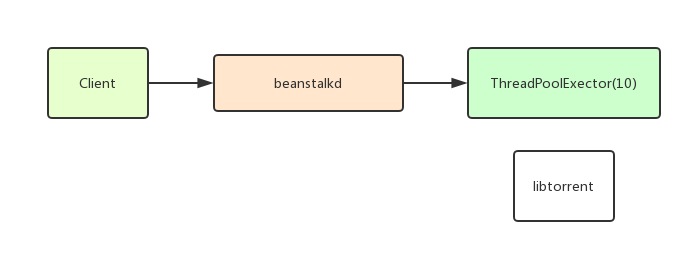整体流程

requirement
# 安装virtualenv
pip install virtualenv
# 创建虚拟环境
virtualenv env
# source
. ./env/bin/activate
安装依赖包
pip install beanstalkc
Client
实现往beanstalkd里面塞hash
import beanstalkc
import sys
if __name__ == '__main__':
if len(sys.argv) < 2:
print("usage: %s <hash>" % sys.argv[0])
sys.exit(1)
if len(sys.argv[1]) != 40:
print("hash code is error.")
sys.exit(1)
beanstalk = beanstalkc.Connection(host = "localhost", port = 11300)
beanstalk.put(sys.argv[1])
print("hash has put")
server
依赖libtorrent下载torrent
wget https://github.com/arvidn/libtorrent/releases/download/libtorrent-1_0_10/libtorrent-rasterbar-1.0.10.tar.gz
tar zxf libtorrent-rasterbar-1.0.10.tar.gz
cd libtorrent-rasterbar-1.0.10
./configure --enable-python-binding PYTHON=`which python` --prefix=$VIRTUAL_ENV LIBS='-liconv'
make -j2 && make install
依赖beanstalkd队列
mkdir /usr/local/beanstalkd/bin
wget https://github.com/kr/beanstalkd/archive/v1.10.tar.gz
tar zxf v1.10.tar.gz
cd beanstalkd-1.10/
make
mv beanstalkd /usr/local/beanstalkd/bin
mkdir /data/beanstalkd/
# /usr/local/beanstalkd/bin/beanstalkd -b /data/beanstalkd/
使用supervisor管理beanstalkd
[program:beanstalkd]
directory = /data/beanstalkd/
command = /usr/local/beanstalkd/bin/beanstalkd -b /data/beanstalkd/
Python2.7 支持 ThreadPoolExecutor 的话还需要 futures 包
pip install futures
上Server端代码
import time
import tempfile
import libtorrent
import os
import os.path as path
import shutil
from concurrent import futures
import beanstalkc
def hash2torrent(torrent_hash, timeout = None):
torrent_hash = torrent_hash.lower()
print("start download: %s" % (torrent_hash))
magnet = "magnet:?xt=urn:btih:" + torrent_hash
directory = path.join("torrents", torrent_hash[0:2], torrent_hash[-2:])
output = path.join(directory, torrent_hash + ".torrent")
if not path.exists(directory):
os.makedirs(directory)
if path.exists(output):
print('Already exists.')
return output
tempdir = tempfile.mkdtemp()
session = libtorrent.session()
session.add_dht_router('router.bittorrent.com', 6881)
session.add_dht_router('router.utorrent.com', 6881)
session.add_dht_router('router.bitcomet.com', 6881)
session.add_dht_router('dht.transmissionbt.com', 6881)
session.add_dht_router("dht.aelitis.com", 6881)
session.start_dht()
params = {
'save_path': tempdir,
# 'storage_mode': libtorrent.storage_mode_t(2),
# 'paused': False,
# 'auto_managed': True,
'duplicated_is_error': True
}
handle = libtorrent.add_magnet_uri(session, magnet, params)
cost = 0
while not handle.has_metadata():
if timeout is not None and cost > timeout:
print("Timeout.")
# session.pause()
session.remove_torrent(handle)
shutil.rmtree(tempdir)
return None
time.sleep(1)
cost = cost + 1
# session.pause()
print("Downloaded. %d" % (cost))
# print 'got metadata, starting torrent download...'
# while handle.status().state != libtorrent.torrent_status.seeding:
# s = handle.status()
# state_str = ['queued', 'checking', 'downloading metadata', 'downloading', 'finished', 'seeding', 'allocating']
# print '%.2f%% complete (down: %.1f kb/s up: %.1f kB/s peers: %d) %s %.3f' % (s.progress * 100, s.download_rate / 1000, s.upload_rate / 1000, s.num_peers, state_str[s.state], s.total_download/1000000)
# time.sleep(3)
torrent_info = handle.get_torrent_info()
torrent_file = libtorrent.create_torrent(torrent_info)
torrent_content = libtorrent.bencode(torrent_file.generate())
with open(output, "wb") as f:
f.write(torrent_content)
f.close()
session.remove_torrent(handle)
shutil.rmtree(tempdir)
return output
if __name__ == '__main__':
beanstalk = beanstalkc.Connection(host='localhost', port=11300)
timeout = None
with futures.ProcessPoolExecutor(10) as executor:
while True:
job = beanstalk.reserve()
torrent_hash = job.body
job.delete()
executor.submit(hash2torrent, torrent_hash, timeout)
实测,平均每个种子的下载时间需要 15 分钟左右。


